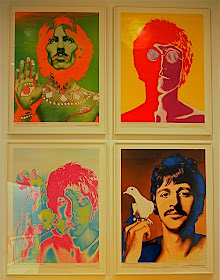
This is RICHARD AVEDON'S lithograph (1967) entitled, "George Harrison, Paul McCartney, John Lennon, Ringo Starr" on exhibit at the Museum of Modern Art. Richard Avedon was an American photographer credited with raising fashion photography to an art form. He also became one of the most acclaimed portrait photographers of the 1900's. In 1967, he created the famous Beatles posters which were printed and sold in Germany.
The original Beatles catalogue has been digitally re-mastered for the first time, for worldwide CD release last Wednesday, September 9, 2009, the same date as The Beatles: Rock Band!
About Richard Avedon (from wikipedia):
Richard Avedon (May 15, 1923 – October 1, 2004) was an American photographer. Avedon capitalized on his early success in fashion photography and expanded into the realm of fine art. Avedon was born in New York City to a Jewish-Russian family. After briefly attending Columbia University, he started as a photographer for the Merchant Marines in 1942, taking identification pictures of the crewmen with his Rolleiflex camera given to him by his father as a going-away present. In 1944, he began working as an advertising photographer for a department store, but was quickly discovered by Alexey Brodovitch, the art director for the fashion magazine Harper's Bazaar. Lillian Bassman also promoted Avedon's career at Harper's.
In 1946, Avedon had set up his own studio and began providing images for magazines including Vogue and Life. He soon became the chief photographer for Harper's Bazaar. Avedon did not conform to the standard technique of taking fashion photographs, where models stood emotionless and seemingly indifferent to the camera. Instead, Avedon showed models full of emotion, smiling, laughing, and, many times, in action.
In 1966, Avedon left Harper's Bazaar to work as a staff photographer for Vogue magazine. He proceeded to become the lead photographer of Vogue and photographed most of the covers from 1973 until Anna Wintour became editor in chief in late 1988 [1][2]. Notable among his fashion advertisement photograph series are the recurring assignments for Gianni Versace, starting from the spring/summer campaign 1980.
In addition to his continuing fashion work, Avedon began to branch out and photographed patients of mental hospitals, the Civil Rights Movement in 1963, protesters of the Vietnam War, and later the fall of the Berlin Wall. During this period Avedon also created two famous sets of portraits of The Beatles. The first, taken in mid to late 1967, became one of the first major rock poster series, and consisted of five striking psychedelic portraits of the group — four heavily solarised individual colour portraits (solarisation of prints by his assistant, Gideon Lewin, retouching by Bob Bishop) and a black-and-white group portrait taken with a Rolleiflex camera and a normal Planar lens. The next year he photographed the much more restrained portraits that were included with The Beatles in 1968. Among the many other rock bands photographed by Avedon, in 1973 he shot Electric Light Orchestra with all the members exposing their bellybuttons for recording, On the Third Day.
Avedon was always interested in how portraiture captures the personality and soul of its subject. As his reputation as a photographer became widely known, he brought in many famous faces to his studio and photographed them with a large-format 8x10 view camera. His portraits are easily distinguished by their minimalist style, where the person is looking squarely in the camera, posed in front of a sheer white background. Avedon would at times evoke reactions from his portrait subjects by guiding them into uncomfortable areas of discussion or asking them psychologically probing questions. Through these means he would produce images revealing aspects of his subject's character and personality that were not typically captured by others.[3]
He is also distinguished by his large prints, sometimes measuring over three feet in height. His large-format portrait work of drifters, miners, cowboys and others from the western United States became a best-selling book and traveling exhibit entitled In the American West, and is regarded as an important hallmark in 20th Century portrait photography, and by some as Avedon's magnum opus. Commissioned by the Amon Carter Museum in Fort Worth, Texas, it was a six-year project Avedon embarked on in 1979, that produced 125 portraits of people in the American west who caught Avedon's eye.
Avedon was drawn to working people such as miners and oil field workers in their soiled work clothes, unemployed drifters, and teenagers growing up in the West circa 1979-84. When first published and exhibited, In the American West was criticized for showing what some considered to be a disparaging view of America. Avedon was also lauded for treating his subjects with the attention and dignity usually reserved for the politically powerful and celebrities. Laura Wilson served as Avedon's assistant during the creation of In the American West and in 2003 published a photo book documenting the experiences, Avedon at Work, In the American West.
Avedon became the first staff photographer for The New Yorker in 1992 [4]. He has won many awards for his photography, including the International Center of Photography Master of Photography Award in 1993, the Prix Nadar in 1994 for his photobook Evidence, and the Royal Photographic Society 150th Anniversary Medal in 2003.

No comments:
Post a Comment